Grammar and Teaching Communication Assignment 2022
This research paper aims to elucidate the role of grammar in teaching a foreign language, based on the methodology of communicative language teaching. The paper explores the goals of foreign language teaching, the place of grammar in the classroom, and proposes classroom activities. The author also includes a summary of the findings from a questionnaire on the importance of grammar in foreign language teaching.
Added on 2022-08-24
Grammar and Teaching Communication Assignment 2022
This research paper aims to elucidate the role of grammar in teaching a foreign language, based on the methodology of communicative language teaching. The paper explores the goals of foreign language teaching, the place of grammar in the classroom, and proposes classroom activities. The author also includes a summary of the findings from a questionnaire on the importance of grammar in foreign language teaching.
Added on 2022-08-24
GRAMMAR AND TEACHING COMMUNICATION
Pieter van Ellewee
ID 7807145061082
29/3/2020

Table of Contents
1. Introduction.........................................................................................................................3
3. Research Purpose................................................................................................................4
4. Research Question..............................................................................................................5
4. Literature Review...................................................................................................................5
I. The Goals of Foreign Language Teaching..........................................................................5
II. The Place of Grammar in a Foreign Language Classroom................................................8
III. Proposed Classroom Activities.......................................................................................12
5. Research Scope.................................................................................................................20
6. Research Design...............................................................................................................20
7. Epistemology....................................................................................................................21
8. Data collection..................................................................................................................21
9. Time Frame.......................................................................................................................22
10. Potential Participants of the Research Study................................................................25
11. Resources for the Research Study.................................................................................25
12. Results and Findings.....................................................................................................25
Teacher Participants’ Profiles..............................................................................................25
Results of Questionnaire.......................................................................................................26
13. Research Limitations.....................................................................................................28
14. Conclusion.....................................................................................................................29
15. References:....................................................................................................................31
Appendices:..............................................................................................................................33
Appendix 1: Blank Questionnaires.......................................................................................33
Appendix 2: Data Breakdown..............................................................................................34
Appendix 3: Analysis- Summary.........................................................................................34
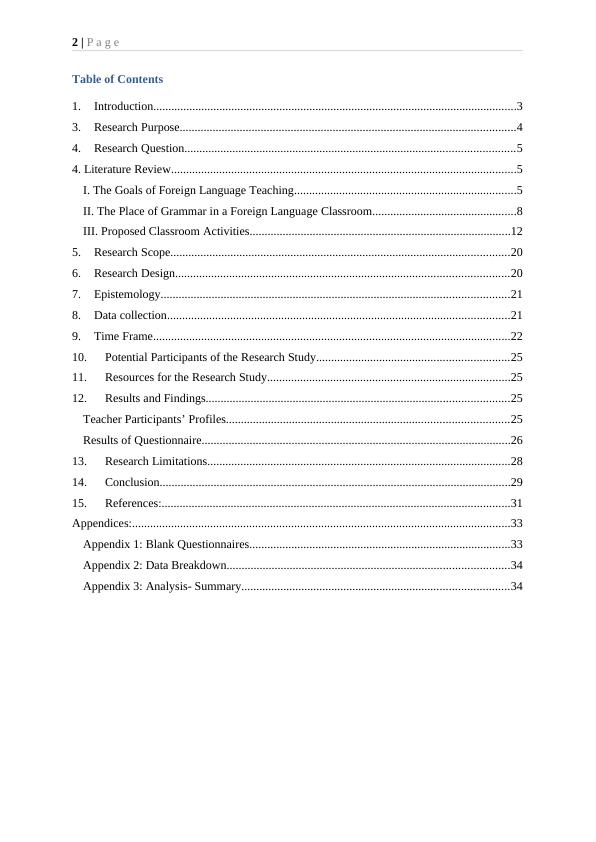
1. Introduction
This paper is an attempt to elucidate the role of grammar in the complex and multifaceted
phenomenon of teaching a foreign language. The research is based on the methodology that
has been predominant in the English language teaching (“ELT”) for the past decades, i.e.,
communicative language teaching (“CLT”).
Background I am an ESL Teacher in China since June 2019 and I joined a Language centre
that gives English to Chinese Kids from ages 4 – 16 years old. It is such a lucrative
environment and many countries use these types of services. I got my Teaching English as a
Foreign language certification. I also did various courses on Teaching English and methods to
assist in Teaching English
Among the core assumptions of current CLT formulated by Jack Richards, the most relevant
to our topic are (a) engaging learners in interaction and meaningful communication; (b) using
exercises that provides opportunities for students to exchange meaning, develop their
language resources, notice how language is used, and take part in meaningful interpersonal
exchange; (c) providing students with content that is relevant, purposeful, interesting, and
engaging; and (d) developing several language skills which are contributing to students’
overall communicative competence (Richards, pp. 22-23).
Grammar, therefore, should be “taught and practiced as a means of communication”. In this
way, it “becomes a more purposeful and therefore a more motivating focus for classroom
learning” (New Ways, p. ix).
The focus on communicative competence or efficiency does not undermine the importance of
grammar instruction. M. Celce-Murcia argues that “there is no empirical evidence that to do
so is ultimately more beneficial to second-language learning” (Celce-Murcia, pp. 13-14).
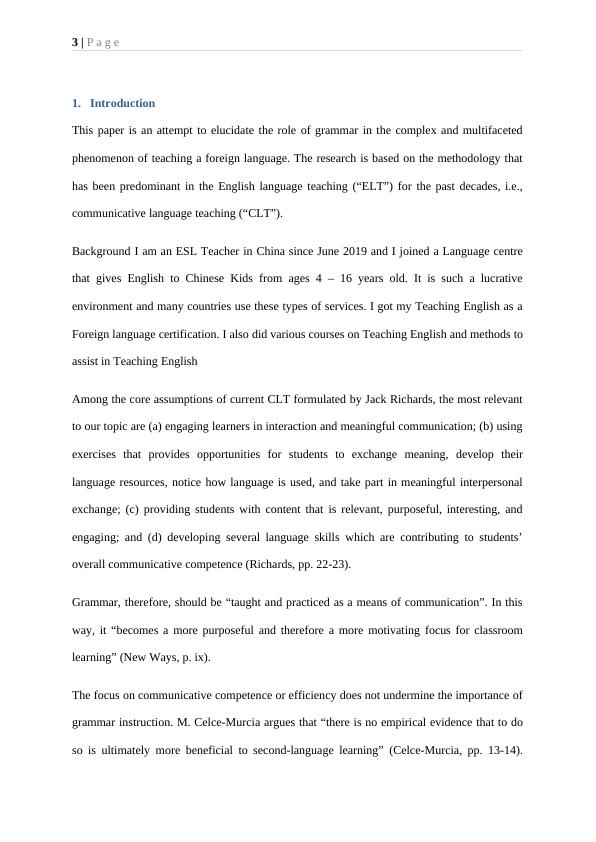
Teaching grammar as a means of communication involves equipping students with
knowledge required for a meaningful use of the language, being knowledge about rules of
sentence formation, together with knowledge how to utilize rules for the purpose of
producing utterances appropriate for a particular communicative purpose in a particular
context (Walcott, p. 9; Nunan, p. 34).
An overview of three of the most popular English textbooks demonstrates that the common
approach to teaching grammar is introducing it in close interconnection with vocabulary and
practicing it thoroughly in a variety of activities involving speaking, reading and writing.
The last chapter includes some conversational activities which can be used for practicing
certain grammar rules within teaching topics that should be of interest to students of different
levels
2. Abbreviations
ELT - English language teaching
CLT - Communicative language teaching
L2 – Persons second language
T – Teacher
S – Student
SS- Student to Student
R - Review
3. Research Purpose
The purpose of the research study is to explore or examine the role that grammar plays in the
teaching a foreign language. Many authors are of the view that the knowledge of grammar
helps the students in correcting their mistakes and improve their written work (Faraj 2015,
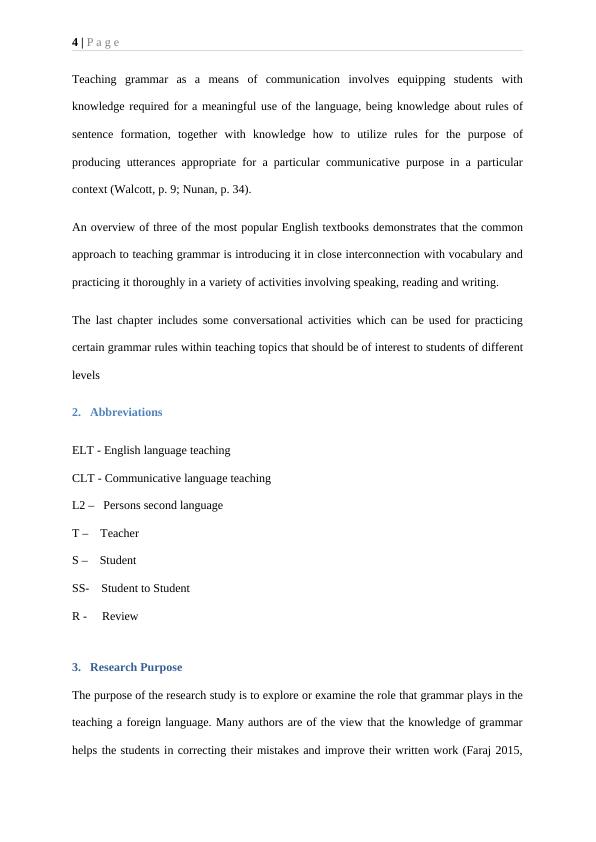
pp. 135). It means that an individual cannot learn a foreign language properly without
unconscious assimilation. It is the grammar that acts as a sure ground of reference when the
other linguistic habits fail. Therefore, grammar is something that is indispensable for the
students. For this reason, the key objectives of this study are as follows:
a) To examine the impact of knowing grammar on the learning of a foreign language
b) To examine the advantages of grammar in the improvement of written work
4. Research Question
Considering the purpose of the research report, following research questions are being
proposed:
a) What is influence of grammar on the better teaching of a foreign language?
b) What is the role of grammar in the improvement of communicative competencies of
students?
4. Literature Review
I. The Goals of Foreign Language Teaching
The website of the publishing house Pearson Longman is quite straightforward in its vision of
the primary aim of English language teaching: it is “teaching the practical use of English for
communication with native speakers and others”. This falls within the concept of
communicative methodology, one of the most important principles of which is teaching the
foreign language as a system of communication (http://www.pearsonlongman.com/teaching-
tips/communication-method.html).
The principles of CLT methodology, according to J. Richards (Richards, pp. 12-13), are the
following:
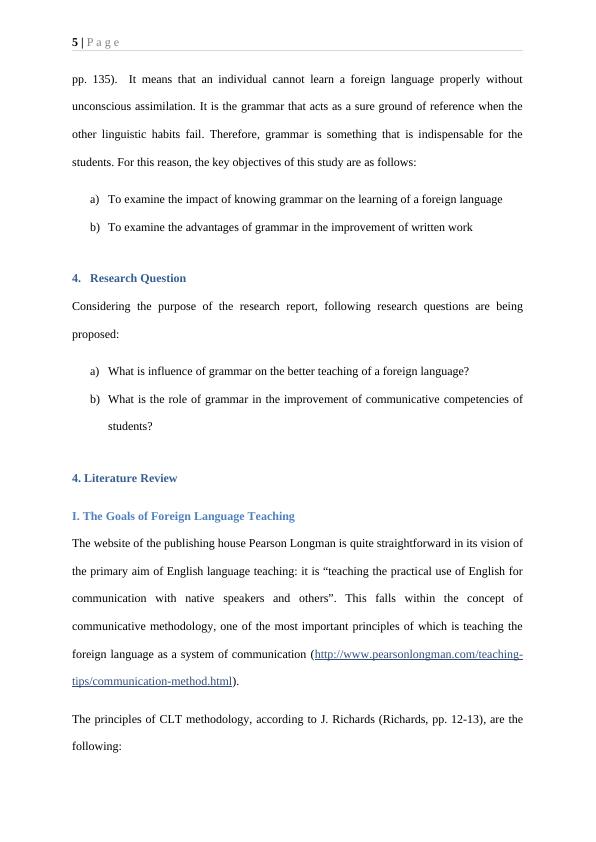
Make real communication the focus of language learning.
Provide opportunities for learners to experiment and try out what they know.
Be tolerant of learners’ errors as they indicate that the learner is building up his or her
communicative competence.
Provide opportunities for learners to develop both accuracy and fluency.
Link the different skills such as speaking, reading, and listening together, since they
usually occur so in the real world.
Let students induce or discover grammar rules.
Therefore, bearing in mind that “knowing a language means knowing how it fulfills
communicative function” (Walcott, p. 9), the foreign language teacher must try to create (or
rather simulate) a ‘real world’ atmosphere in the classroom. The target linguistic material
(vocabulary, grammar, etc.) should be taught in a sequence of meaningful activities related to
the learners’ (a) communicative purpose as well as (b) experience and general knowledge
about the world, in other words, “through performance of communicative tasks” (New
Perspectives, p. 138).
It is argued that, in order to achieve this goal, the syllabus designers must take into
consideration the following aspects of language use: (Richards, pp. 9-10).
1. As detailed a consideration as possible of the purposes for which the learner wishes
to acquire the target language; for example, using English for business purposes, in
the hotel industry, or for travel
2. Some idea of the setting in which they will want to use the target language, for
example, in an office, on an airplane, or in a store
3. The socially defined role the learners will assume in the target language, as well as
the role of their interlocutors; for example, as a traveller, as a salesperson talking to
clients, or as a student in a school
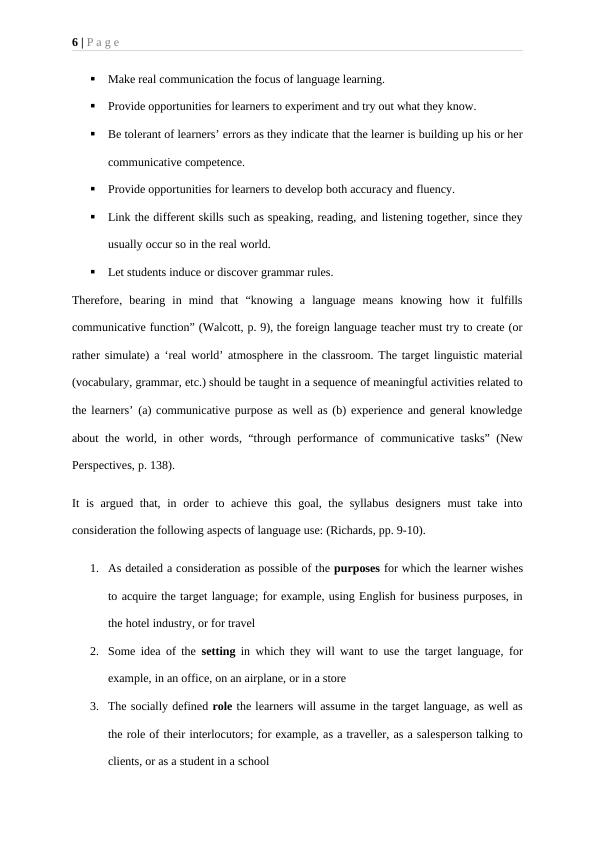
4. The communicative events in which the learners will participate everyday situations,
vocational or professional situations, academic situations, and so on; for example,
making telephone calls, engaging in casual conversation, or taking part in a meeting
5. The language functions involved in those events, or what the learner will be able to
do with or through the language; for example, making introductions, giving
explanations, or describing plans
6. The notions or concepts involved, or what the learner will need to be able to talk
about, for example, leisure, finance, history, religion
7. The skills involved in the “knitting together” of discourse: discourse and rhetorical
skills; for example, storytelling, giving an effective business presentation
8. The variety or varieties of the target language that will be needed, such as American,
Australian, or British English, and the levels in the spoken and written language
which the learners will need to reach
9. The grammatical content that will be needed
10. The lexical content, or vocabulary, that will be needed (Richards, pp. 9-10).
In fact, aspects 1 through 8 predetermine the grammatical and lexical content of any language
activity. A classroom activity aimed at teaching students to produce communicatively
efficient utterances consists of (a) presentation of the target material in a communicative
context (i.e., realistic social situations, language texts, and visual stimuli that are interesting
and meaningful to students (Celce-Murcia, p. 171)), (b) practice of the target material in a
number of meaningful tasks under the teacher’s guidance, and (c) presentation, or “immediate
creativity” (Harmer, p. 60) allowing students to demonstrate their grasp of the linguistic and
paralinguistic material that has been taught in a simulated real life situation.

II. The Place of Grammar in a Foreign Language Classroom
a. Teaching Grammar in CLT Context
Grammar has been the subject of methodological debate for many years. The central, almost
Shakespearian, issue is “To teach or not to teach?” Today, no one can deny or diminish the
significant role that learning grammar plays in a foreign language classroom. M. Rinvolucri,
for example, believes that grammar is “so serious and central in learning another language
that all ways should be searched for which will focus student energy on the task of mastering
and internalising it” (Rinvolucri, p. 3).
In CLT, the mentioned ways are activities that “seek to develop students’ communicative
competence through linking grammatical development to the ability to communicate”.
Grammar, therefore, “is not taught in separation but often arises out of a communicative
assignment, thus creating a need for specific items of grammar” (Richards, pp. 23-24). M.
Celce-Murcia emphasizes “the importance of teaching all aspects of grammar in context”
(Celce-Murcia, p. 171). To R. Ellis, the main components of grammar instruction are
“communicative tasks, designed to engage learners in the receptive and productive processes
involved in using language to convey messages” (New Perspectives, p. 25).
The most common ways of introducing grammar in the classroom are deductive (through
explicit instruction) and inductive (through implicit instruction, discovery-based) methods.
Depending on the situation, both ways are effective, but inductive method, as more
motivating and encouraging students’ analytical thinking, is considered to be more in line
with CLT principles for example, sees the following advantages of implicit grammatical
instruction: “First, it is potentially more motivating than simply being told a grammatical rule
and, for this reason, students may be more likely to remember what they learn. Second, it can
encourage students to form and test hypotheses about the grammar of the L2 [...] Third, it
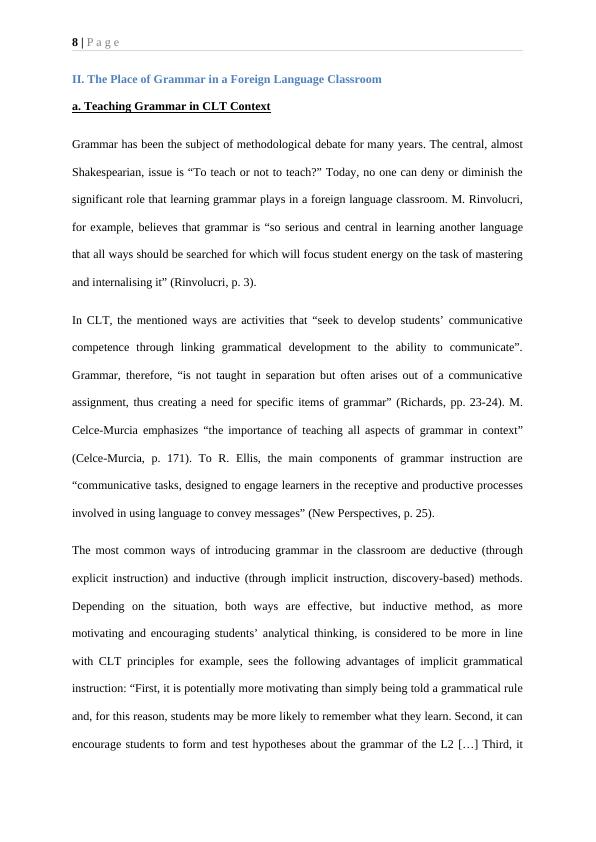
End of preview
Want to access all the pages? Upload your documents or become a member.
